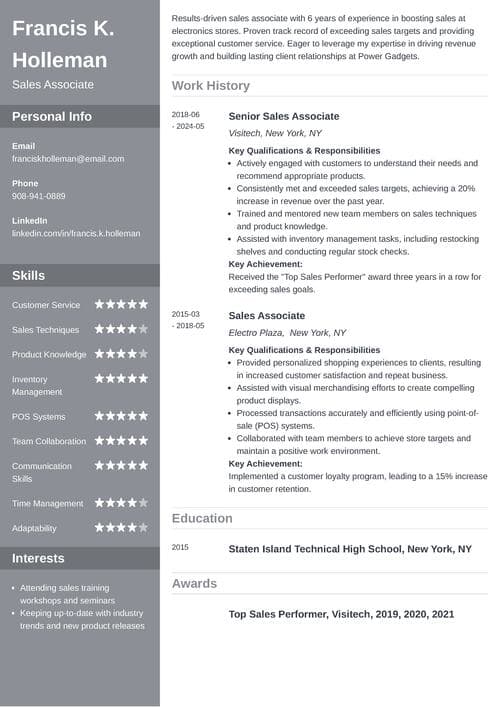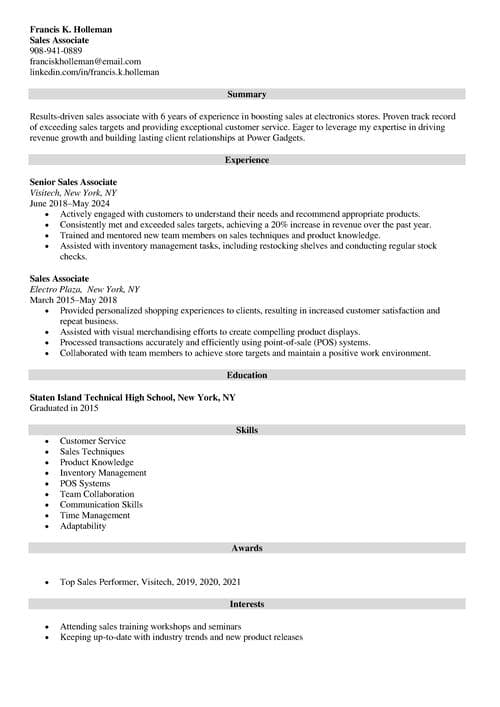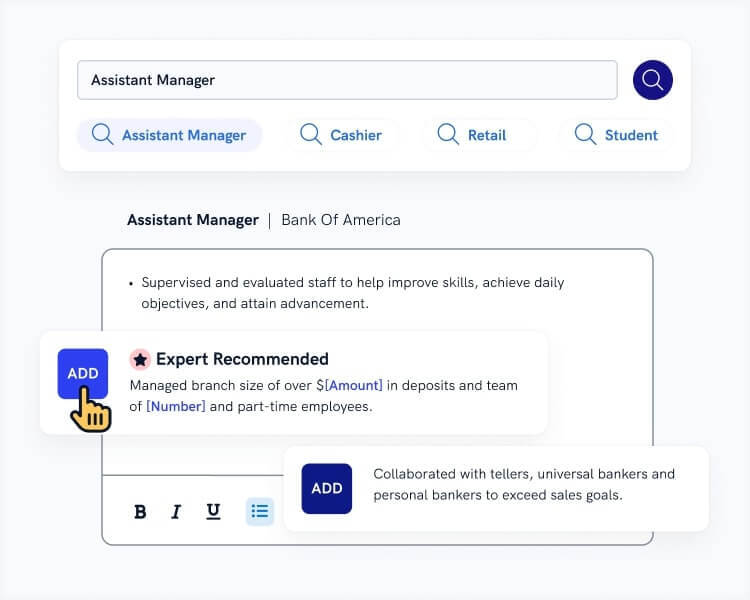It's recommended for a resume to go back 10-15 years. However, sometimes the best answer to the question of how far back to go on your resume is a bit different—it all depends on your work experience. Read on to find out exactly how far back should your resume go.
In this article you’ll learn:
- How far back should your resume go, depending on your situation.
- What hiring managers say about how far back to go on a resume.
- How to list old jobs on a resume and explain experience gaps.
- How many jobs should you list on a resume.
- How to make your work history relevant.
Want to save time and have your resume ready in 5 minutes? Try our resume builder. It’s fast and easy to use. Plus, you’ll get ready-made content to add with one click. See 20+ resume templates and create your resume here.
Sample resume made with our builder—See more resume examples here.
These guides may also be useful to you:
- How Long Should Your Resume Be
- How to Make a Resume Fit on One Page
- How to Write a Targeted Resume
- Can a Resume Be 2 Pages?
- 500+ Resume Examples Any Profession
How Many Years Back Should a Resume Go?
In general, a resume should go back even 10–15 years, assuming it's all relevant experience. However, how many years of experience on a resume is optimal depends on your work history: your experience level, and whether you have gaps in employment or scored freelance gigs.
So, let’s take a closer look at how many years of work experience should be on a resume:
Entry-Level Positions (0–5 Years of Experience)
How many jobs should you list on a resume for an entry-level position? The answer is simple.
If you’re writing a resume and have just a little work experience:
- List all paid and voluntary work you’ve done.
- Name skills and accomplishments that match a job description.
- Remember about internships, part-time jobs, authorial projects, and freelancing.
And what if you’re writing a resume without any professional work experience? How far should you go back on a resume in such a case? You should add all paid and unpaid work experience, including:
- internships
- volunteering experience
- roles in student organizations
- practicums.
Put your resume’s job descriptions below your education section if you’ve just graduated or have very little professional experience.
Mid-Level Positions (5–12 Years of Experience)
If you’re writing a resume for a mid-level vacancy, a 10-year career history is your optimum. So:
- Focus on the positions relevant to the job offer and describe them in more detail.
- Mention the remaining jobs, including short-term and freelance work. But don’t elaborate on these.
Theresa Santoro, Director of Operations and Human Resources at Actualize Consulting, supports the up-to-10-year experience section format:
I tend to hone in on the most recent 5 years of work experience. However, I will review and consider up to the last 10 years of professional experience. Anything more than 10 years back, I will scan for keywords relevant to the job description I am trying to source for.
Senior Positions (+12 Years of Experience)
When it comes to senior positions, employers often look for candidates with lots of professional experience. But it doesn’t mean they’re interested in those back-in-the-day jobs.
When writing the experience section on your senior resume:
- Go as far back as 15 years and list relevant work experience.
- Follow the job posting—the expected years of expertise are usually mentioned there.
Focus on relevance first. Listing your entire career history on a resume for a senior position may lead the recruiter to conclude that you’re overqualified.
Academic Positions
CVs for academic positions must prove a candidate’s research and teaching skills. Universities want to learn your academic history—which usually covers more than 10 years.
In the academic job search for instructors, adjunct or associate professors, or tenured professors, the “Curriculum Vitae” (Latin for life story) should be as far back as 15-20 years, especially if that experience includes teaching, instruction, training, and other educational-related information about their experience.
Pro Tip: No matter how far back you go on a resume—usually it’s best to do it in reverse-chronological order. List recent experience first, then follow up with older jobs.
Making a resume with our builder is incredibly simple. Follow our step-by-step guide, use ready-made content tailored to your job and have a resume ready in minutes.
When you’re done, Zety’s resume builder will score your resume and our ATS resume checker will tell you exactly how to make it better.
How Many Jobs Should You List on a Resume?
How many jobs should you put on a resume? You should list as many jobs as possible, assuming they’re all relevant and you're not exceeding the 10-15-year limit. The number of jobs typically varies between 7 and 3.
Should you list unrelated work experience on a resume? Do it only if you don’t want to create gaps in your resume. Otherwise, it's a waste of space.
You can list old but relevant jobs on your resume in a few ways. Brianna Rooney (aka TheMillionaireRecruiter.com), the founder and CEO of Techees.com with 12 years of experience recruiting software engineers, has some great resume advice—she suggests adding them in a separate resume section:
If you have amazing projects or accomplishments that date further back, then you can have a spot for that, but keep it brief. You can add “notable projects” or “notable accomplishments.” I’d suggest adding only a couple of sentences under each one. I don’t feel adding dates to them is necessary. If it’s too long ago, they won’t look at it. That goes back to the “what have you done lately, and what can you do for me now.”
This extra resume section may also be called Additional Experience or Earlier Experience.
For more extended experience periods that you find relevant—use the format presented below:
Old Job—Years of Experience Within the Same Company
Staff Accountant, 2000–2010
Hyatt and White, ProAccounting Services, NewMed Co.
When listing promotions and multiple positions on a resume, write separate entries under the umbrella of the company name if the positions you held had different duties:
Old Job—Similar Experience, Different Companies
ProAccounting Services
- Staff Accountant, 2008–2010
- Accountant, 2006–2008
- Accounting Assistant, 2004–2006
How to List Career Gigs on a Resume?
64 million Americans did freelance work in 2023, translating to 38% of the U.S. workforce. In fact, the majority of workers in the U.S. are expected to be freelancers by 2027. If you’re a freelancer, how should you make your resume if your work history consists only of those career gigs?
Show off your skills instead of writing a boring list of titles, company names, and dates on your resume. Focus on 2 or 3 jobs most relevant to the job ad and describe them in more detail.
A combination resume format (also called a hybrid resume) will help you do that. It combines the features of the reverse-chronological resume and the skills-based resume.
It’s a win-win resume format for:
- Career changers: as it allows them to elaborate on the skills relevant to the job ad.
- Seasoned professionals with plenty of work experience: it makes it easy for them to promote only the best career achievements.
- Candidates with gaps in employment: it gives them a chance to prove their skills regardless of their work history.
Learn how to create a hybrid resume thanks to our dedicated guide: Combination Resume Template & 5+ Examples [Complete Guide]
How to Keep Your Work Experience Relevant?
Most hiring managers agree that work experience relevance is more important than its length.
Relevant means valuable. So it’s not only about how much work experience to include on a resume but also which of your past jobs you include.
A resume is the vessel used to get an interview, not the job. You need to have something that sums up your experience as best it can without it being too lengthy or too vague. A lot of people want to hang on to the past when companies really want to know, “What have you done lately and what can you do for me now.”
So, how to guide the recruiter toward relevant career moments?
- Make sure your resume and job description match.
- Recognize the employer’s needs and address them directly.
- Name quantifiable achievements that prove you fit the requirements
- Use bullets to showcase your job experiences in a clear way.
As I’ve mentioned before, the question is not how many jobs should be listed on a resume but—how to find the appropriate ones. What exactly does it mean? If you want to be a sales associate—focus only on the sales-related jobs on your resume.
Pro Tip: Trying to tailor your resume to the job ad, but you have never done the same job in the past? Think of the positions that are most related to the position you’re applying for and show your transferable skills.
Plus, a great cover letter that matches your resume will give you an advantage over other candidates. You can write it in our cover letter builder here. Here's what it may look like:
See more cover letter templates and start writing.
Key Takeaway
How much job history on a resume is enough? As always, the only correct answer is: it depends. However, as long as you pick relevant positions, jobs, or even gigs, any arbitrary cut-off is meaningless. Avoid going beyond 20+ years of experience unless required. Tailor, trim, cut, and whatever is left is the right length.
About Zety’s Editorial Process
This article has been reviewed by our editorial team to make sure it follows Zety's editorial guidelines. We’re committed to sharing our expertise and giving you trustworthy career advice tailored to your needs. High-quality content is what brings over 40 million readers to our site every year. But we don't stop there. Our team conducts original research to understand the job market better, and we pride ourselves on being quoted by top universities and prime media outlets from around the world.




